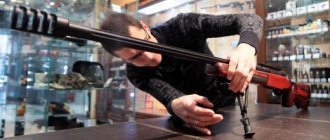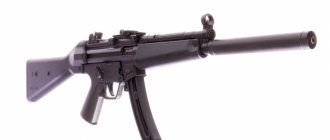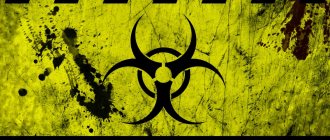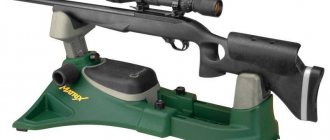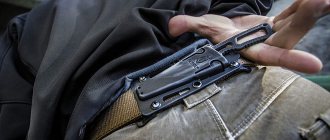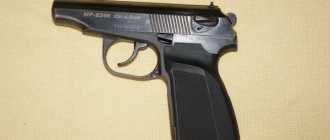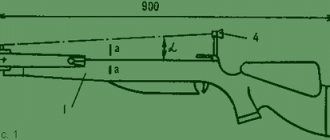Signal flares are the main means of signaling in any conditions. This quality is not possessed by all other signaling means, for example, flags, pennants. A flare can be launched from any place in the open air, from a shelter, from a building window, from a narrow street. In this case, the signal will be visible for many kilometers, the rocket is understood to a considerable height. It is impossible to achieve the same effect using other available signaling means.
The meaning of the color of signal cartridges and flares
Signal cartridges have different colors for a reason. In wartime they are used to give commands to their troops. Thus, a green signal star directed towards the enemy gave a command to open fire. A series of red stars signaled a ceasefire command. A series of chaotic green stars signaled a ceasefire command. When emergencies occur at enterprises, then one yellow light is issued upward to facilitate the actions of rescuers.
Flare RPSP-40 green
In addition, experienced tourists use signal flares to communicate with each other. Green stars indicate the direction the team is moving. Red ones show where you can’t go. Yellow - upwards indicate parking. When rescuers communicate, green flares mean “yes,” red flares mean “no,” and yellow flares mean “not clear.” Launching any three colors (preferably red) at short intervals is a distress signal.
Color additives for smoke and light signals
Only red, green and white (colorless, white-yellow) missiles are widely used by the military. For them, color additives are well developed and optimized:
- Red flame color and red smoke signal - strontium nitrate;
- The green color of the flame and smoke is barium nitrate;
- Blue and cyan color - copper chloride;
- Yellow - sodium, sodium compounds;
- The white color of the flame and white smoke are various gunpowders, aluminum.
These are general signal designations. Any other schemes can be used by prior agreement.
All other colors (purple, carmine, orange) are obtained by mixing metal salts. The use of organic dyes has also been used for a long time and is promising in production. For example, signal orange smoke is produced by simply adding a dye of the appropriate color.
White flares are usually called simply flares. Their pyrotechnic composition is designed to produce a bright white flame with combustion and the highest possible light output. There is a simple and objective calculation method: the ratio of light intensity in CD per each weight unit of the composition is measured.
Signals
The flare must be as visible as possible, so two effects are used here: either smoke or light. Accordingly, flares are used for lighting and signaling at night, and smoke flares are used during the day. In any conditions, it is recommended to take two types of rockets with you. Poor visibility and wind significantly reduce their effectiveness. The smoke flare is visible for several minutes. Lighting - for a few seconds, but special variations with a parachute are offered. They work for several tens of seconds.
What is a clear (white) beacon?
The clear light of a lighthouse does not mean much. When used, the clear dome is used in other settings where there is doubt about using red, yellow, green or blue. Whether clear dome lighting requires supervision or employee intervention must be assessed individually for each application.
Under no circumstances should a clear dome be used for buttons with stop or shutdown functions. The brightness of white beacon lights is very high as they have the highest light transmittance. Despite its high light transmittance, a transparent dome is not suitable for attracting attention and warning of danger.
Reduced light transmission:
- Halogen: 0%
- Xenon: 0%
- LED: -9%
SOS signal in Morse code
Every person has heard of such concepts as the SOS distress signal and Morse code. The radio signal has long been firmly established in maritime affairs.
But do not assume that such distress signals are used on the ship and nowhere else. The ability to give and recognize SOS in Morse code will increase the chances of rescue at sea, land, in the mountains and even in the city. So don’t be lazy and learn how to send the universal SOS distress signal in Morse code right now.
To attract the attention of rescuers, several methods of giving the SOS signal are used (the category depends on the situation in which the victim finds himself). But more on that later.
First, let's figure out what combination of characters forms the SOS distress signal in Morse code: 3 dots, 3 dashes, 3 dots. If you want to hear what it sounds like, watch the theme video.
History of the SOS signal
Invented in 1835, Morse code was actively used by sailors. A simple combination of sounds helped to prevent dangerous situations and escape when they occurred.
Almost 100 years later, radio broadcasting appeared and each communications provider company sought to monopolize a new niche and installed its own radio beacons with a unique message on ships. Thus, there was no one-size-fits-all notification of danger.
Everything changed after a conference on radiotelegraphy in 1906, where a common, simple combination that is still used today was chosen: three dots, three dashes, three dots. To prevent the distress signal from being lost on the air, a silence mode was established every half hour, lasting 3 minutes.
Note ! Many people consider the name of the SOS signal to be an abbreviation, they puzzle over how it is translated, and try to decipher it. Don't waste your time, the common distress signal cannot be deciphered.
Now let's move on to signals that warn of danger in certain conditions, and consider how to give them.
Sound: beeps, shots, knocking and other sounds
If you have a record player, portable speakers, cell phone, or other device with a speaker, sending an SOS notification is especially easy. Loud sounds, periodically reproduced in a certain rhythm, will certainly attract the attention of rescuers.
Sound directed downwind will travel further, and tall obstacles in the way “eat up” the power of the sound.
Shots will be clearly audible at a great distance.
If you are sure that rescuers are somewhere nearby, use a whistle or car horn.
Note! It is very easy to sound a distress signal using a whistle or horn.
Now pay attention to how to knock or “shoot” SOS using a firearm: 3 knocks/shots with short pauses between them, 3 with long pauses, again 3 with short ones. Pause for a minute and repeat.
Many objects can alert you to your plight; you just need to use a little ingenuity. The main thing is not to forget that the SOS signal in Morse code is recognized by the minute pause between notifications.
Light: flashlights, flash, sunbeams
If you have nothing to send an audible distress signal or need to communicate yourself without noise, send an SOS signal with light. But don’t forget, light sources “work” best at night.
Note! The easiest way is to use a self-charging solar-powered camping flashlight. The distress message is given by alternating flashes: 3 short, 3 long, 3 short, with the light source covered by hand. Remember to pause for a minute after each transmission.
If you have a camera with a flash pointed at a reflective surface, you can report your plight. However, the flash is short-lived, so the dash function will be performed by longer intervals between flashes.
On a sunny, clear day, give an SOS signal in Morse code with the light from the “sun bunny”. If you don't have a mirror at hand, use broken glass, chocolate foil, or a polished metal object.
At dusk, a tent with a fire, candle or other light source inside is an excellent reference point.
Exotic ways
In open areas and in the absence of means to send an SOS distress signal in Morse code, you can write the word itself. Many people post SOS with fire, after which, after burning, soot remains on the ground, easily visible from above, repeating the outlines of the letters calling for salvation.
If you can’t get a fire, lay out letters from the means at hand: bright clothes, fruits, large stones of contrasting colors, a mound of wet sand, etc. If there is nothing else, dig deep and wide grooves in the shape of SOS.
Attention! Remember that the inscription should stand out on the ground and be visible from the air.
When laying out letters, keep straight lines and maintain right angles. The size of the inscription is at least several meters.
To survive, savvy people signal using smoke, a sheet, a flag and other things. The main thing is not to lose heart, use your wits and remember the saving Morse code combination.
What does the purple beacon mean?
The color magenta, or often equated to magenta, plays an important role, especially for US applications. There, purple signal lights are used as an alternative to red signal lights if, for example, the color red is classified as a fire hazard. This signal color represents a particularly dangerous situation, especially in the oil and gas industry.
When the purple warning beacon illuminates, people should immediately leave their surroundings or actions should be carried out by trained personnel.
Comparison table: meaning of signal colors
Types of eye cells
Our eyes have several types of photoreceptor cells called cones, which contain photopigments designed to measure wavelength. Together the cones work to tell the brain the colors we see. During the day, our eyes perceive green light most easily, followed by yellow and blue. This is one of the reasons why the traffic light has a green signal. Red is also used in traffic lights because it stands out against greenery, although red is actually the least visible color from a distance.
